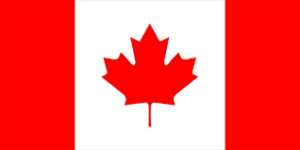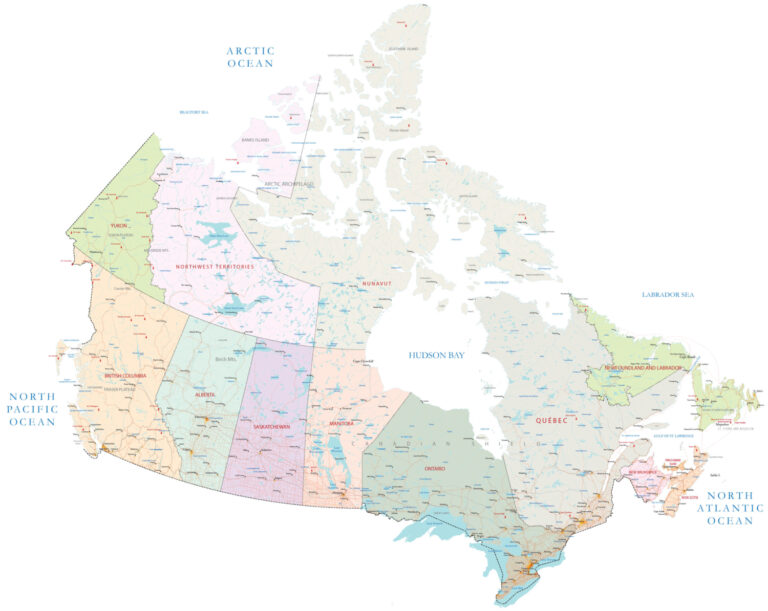Canada Neighboring Countries: U.S.A., Greenland (Denmark)
About Canada
Canada is a North American country located to the north of the United States. It is the world’s second-largest country by total area, with a landmass of 9.98 million square kilometers. Canada is a federation with ten provinces and three territories, and its capital city is Ottawa.
Some Facts about Canada |
|
|---|---|
| Location | North America |
| Capital | Ottawa |
| Largest City | Toronto |
| Official Languages | English and French |
| Population | 38.1 million |
| Area | 9.98 million km² |
| GDP | $2.20 trillion |
| Currency | Canadian dollar |
| Government | Federal parliamentary democracy and constitutional monarchy |
| Prime Minister | Justin Trudeau |
| National Symbols | Maple leaf, beaver, Canadian flag |
| Famous Landmarks | Niagara Falls, CN Tower, Parliament Hill |
Flag of Canada

The flag consists of a red field with a white square at its center, which contains a stylized, 11-pointed red maple leaf. The flag was officially adopted on February 15, 1965, replacing the previous Canadian Red Ensign flag. The red color symbolizes Canada’s sacrifice and valor, while the white represents peace, honesty, and purity. The maple leaf is a national symbol of Canada and represents the country’s cultural heritage and natural beauty. The 11 points on the leaf represent Canada’s 10 provinces and 3 territories. The flag is a recognized symbol of Canada both domestically and internationally and is flown proudly by Canadians on national holidays and other special occasions.
History of Canada
The first recorded contact between Indigenous peoples and Europeans occurred in the late 10th century when the Norse explored the eastern coast of Canada.
In the 16th century, French and English explorers began to explore and establish settlements in Canada. The French established settlements in what is now Quebec and Ontario, while the English established colonies in what is now Newfoundland and Labrador.
In the 18th and 19th centuries, Canada became a battleground for European powers, with the French and British competing for control of the land. In 1867, the British North America Act united the colonies of Canada, Nova Scotia, and New Brunswick, creating the Dominion of Canada.
In the late 20th century, Canada underwent significant cultural and political changes, with the adoption of multiculturalism as an official government policy and the recognition of Indigenous rights.
Geography of Canada
Canada is a vast country located in the northern part of North America, stretching from the Atlantic Ocean in the east to the Pacific Ocean in the west. It is the second-largest country in the world by land area, covering over 9.98 million square kilometers.
Canada has a diverse geography, with a mix of mountains, forests, prairies, and coastal regions. The Rocky Mountains run through western Canada, while the Canadian Shield covers much of the central part of the country. Canada has many lakes and rivers, including the Great Lakes and the Mackenzie River, which is the longest river in Canada.
Climate in Canada
Canada has a varied climate, with colder temperatures in the northern regions and milder temperatures in the southern regions. The country experiences four distinct seasons, with warm summers and cold winters. winters can be long and severe, with heavy snowfall and below-freezing temperatures.
In coastal regions, such as British Columbia, the climate is more temperate due to the influence of the Pacific Ocean.
Provinces in Canada
| Province/Territory | Capital |
|---|---|
| Alberta | Edmonton |
| British Columbia | Victoria |
| Manitoba | Winnipeg |
| New Brunswick | Fredericton |
| Newfoundland and Labrador | St. John’s |
| Northwest Territories | Yellowknife |
| Nova Scotia | Halifax |
| Nunavut | Iqaluit |
| Ontario | Toronto |
| Prince Edward Island | Charlottetown |
| Quebec | Quebec City |
| Saskatchewan | Regina |
| Yukon | Whitehorse |
Note: Canada has ten provinces and three territories
Important cities in Canada
| City | Province | Notable Attractions |
|---|---|---|
| Toronto | Ontario | CN Tower, Toronto Islands, Royal Ontario Museum |
| Vancouver | British Columbia | Stanley Park, Granville Island, Capilano Suspension Bridge |
| Montreal | Quebec | Notre-Dame Basilica, Old Montreal, Montreal Botanical Garden |
| Ottawa | Ontario | Parliament Hill, National Gallery of Canada, Canadian War Museum |
| Calgary | Alberta | Calgary Stampede, Canada Olympic Park, Glenbow Museum |
| Halifax | Nova Scotia | Halifax Citadel, Peggy’s Cove, Halifax Waterfront |
Transportation
Highways in Canada
| Highways | Description |
|---|---|
| Trans-Canada Highway | Longest national highway that spans 7,821 km across Canada |
| Highway 401 | The longest highway in Ontario with 828 km |
| Highway 1 | The longest highway in British Columbia with 1,039 km |
| Highway 2 | Connects major cities in Eastern Canada from Nova Scotia to Ontario |
| Highway 97 | The north-south route through British Columbia and the Yukon |
Airports in Canada
| Airport | Location |
| Toronto Pearson International Airport (YYZ) | Toronto, Ontario |
| Vancouver International Airport (YVR) | Vancouver, British Columbia |
| Montréal–Pierre Elliott Trudeau International Airport | Montreal, Quebec |
| Calgary International Airport (YYC) | Calgary, Alberta |
| Edmonton International Airport (YEG) | Edmonton, Alberta |
Tourist Attractions in Canada
| Tourist Attraction | Location | Description |
|---|---|---|
| Niagara Falls | Ontario | One of the world’s most famous waterfalls |
| Banff National Park | Alberta | Stunning mountain scenery, hot springs, and wildlife |
| CN Tower | Toronto, Ontario | Iconic tower offering sweeping views of the city and beyond |
| Old Quebec | Quebec City, Quebec | Beautiful historic district with a European feel |
| Stanley Park | Vancouver, British Columbia | Urban park with forested trails, beaches, and attractions |
| Butchart Gardens | Victoria, British Columbia | Beautiful floral gardens with over 900 varieties of plants |
| Parliament Hill | Ottawa, Ontario | Home of Canada’s federal government and historic buildings |
| Peggy’s Cove | Nova Scotia | Picturesque fishing village with a lighthouse and rocky coast |
| Churchill, Manitoba | Manitoba | Known as the “polar bear capital of the world” |
| Royal Ontario Museum | Toronto, Ontario | Large museum with world-class exhibits on natural history, art, and culture |
FAQs
FAQ #1: What is the official language of Canada?
English and French.
FAQ #2: What is the capital of Canada?
Ottawa.
FAQ #3: What is the currency of Canada?
The Canadian dollar (CAD).
FAQ #4: What are the major cities in Canada?
Some of the major cities in Canada include Toronto, Vancouver, Montreal, Calgary, and Ottawa.
FAQ #5: What is the population of Canada?
38.1 million (Approx).

